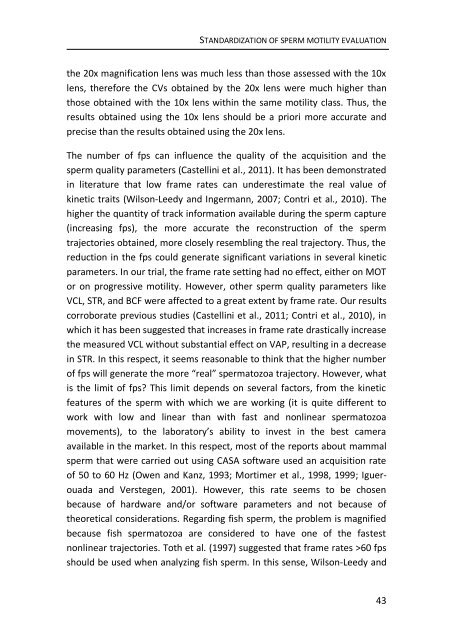chapter 3 - RiuNet
chapter 3 - RiuNet
chapter 3 - RiuNet
Create successful ePaper yourself
Turn your PDF publications into a flip-book with our unique Google optimized e-Paper software.
STANDARDIZATION OF SPERM MOTILITY EVALUATION<br />
the 20x magnification lens was much less than those assessed with the 10x<br />
lens, therefore the CVs obtained by the 20x lens were much higher than<br />
those obtained with the 10x lens within the same motility class. Thus, the<br />
results obtained using the 10x lens should be a priori more accurate and<br />
precise than the results obtained using the 20x lens.<br />
The number of fps can influence the quality of the acquisition and the<br />
sperm quality parameters (Castellini et al., 2011). It has been demonstrated<br />
in literature that low frame rates can underestimate the real value of<br />
kinetic traits (Wilson-Leedy and Ingermann, 2007; Contri et al., 2010). The<br />
higher the quantity of track information available during the sperm capture<br />
(increasing fps), the more accurate the reconstruction of the sperm<br />
trajectories obtained, more closely resembling the real trajectory. Thus, the<br />
reduction in the fps could generate significant variations in several kinetic<br />
parameters. In our trial, the frame rate setting had no effect, either on MOT<br />
or on progressive motility. However, other sperm quality parameters like<br />
VCL, STR, and BCF were affected to a great extent by frame rate. Our results<br />
corroborate previous studies (Castellini et al., 2011; Contri et al., 2010), in<br />
which it has been suggested that increases in frame rate drastically increase<br />
the measured VCL without substantial effect on VAP, resulting in a decrease<br />
in STR. In this respect, it seems reasonable to think that the higher number<br />
of fps will generate the more “real” spermatozoa trajectory. However, what<br />
is the limit of fps? This limit depends on several factors, from the kinetic<br />
features of the sperm with which we are working (it is quite different to<br />
work with low and linear than with fast and nonlinear spermatozoa<br />
movements), to the laboratory’s ability to invest in the best camera<br />
available in the market. In this respect, most of the reports about mammal<br />
sperm that were carried out using CASA software used an acquisition rate<br />
of 50 to 60 Hz (Owen and Kanz, 1993; Mortimer et al., 1998, 1999; Iguerouada<br />
and Verstegen, 2001). However, this rate seems to be chosen<br />
because of hardware and/or software parameters and not because of<br />
theoretical considerations. Regarding fish sperm, the problem is magnified<br />
because fish spermatozoa are considered to have one of the fastest<br />
nonlinear trajectories. Toth et al. (1997) suggested that frame rates >60 fps<br />
should be used when analyzing fish sperm. In this sense, Wilson-Leedy and<br />
43
















